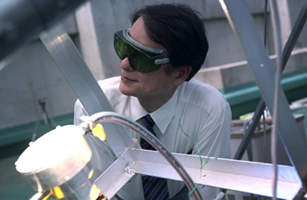
When it comes to subatomic reactions, Takashi Yabe thinks as big as he does small. Yabe had wanted to study the universe when he signed up at Tokyo Institute of Technology (TIT) in 1969. But there was only one space researcher in the engineering department, and early into Yabe's studies he switched to nuclear fusion — so Yabe followed suit. Now a thermal and fluid scientist and laser-fusion expert at TIT, Yabe, 59, uses a huge flat screen to help explain the tiny particles that are a major part of his work: the magnesium energy cycle and the magnesium injection cycle, or MAGIC. Yabe believes that MAGIC, true to its name, could help eliminate our dependence on fossil fuels by allowing us to build a magnesium-based society in which clean energy is powered by the sun.
The oceans contain 1,800 trillion tons of magnesium, Yabe explains, enough to meet the world's energy needs for the next 300,000 years. But the metallic element with a "white-silver glitter" has never been considered a viable energy source because refining it, at temperatures up to 4,000°C (7,200°F), requires a lot of money and energy. Since 2005, however, Yabe and his colleagues have been developing a system of lenses and lasers to harness one of the most readily available sources of energy around. "We use sunlight, and it's free," he says.
First he needs to get the magnesium from the ocean. To do this, Yabe has designed a device that extracts magnesium chloride from seawater — and leaves behind fresh water — using a special evaporation technique.
Next, Yabe and his team turn the magnesium chloride into magnesium oxide and then use 43-sq.-ft. (4 sq m) plastic Fresnel lenses to focus sunlight into lasers and send it down microscopic fibers. The fibers help concentrate the light — and heat — onto magnesium oxide particles inside a vacuum tank. The result is refined magnesium.
For the next stage of the process Yabe has developed a MAGIC engine, which mixes magnesium granules and water to create heat energy and hydrogen that can power a car. The only by-products are water and magnesium oxide, which can be broken down again by Yabe's sunlight laser. He also has plans to sell refined magnesium for use in fuel-cell batteries. Magnesium batteries are seven times more powerful than the lithium-ion batteries that run many of today's hybrid and electric vehicles. "If we can replace all energy combustion with our MAGIC cycle, there will be no CO2 emissions," says Yabe. "No one has proposed such a complete system." The scientist's ultimate vision is one of a massive, solar-powered laser that beams light to a relay satellite that, in turn, sends energy to airplanes and tankers around the world. Now that's thinking big.
GREEN TIP
'Take the stairs. You don't use any electricity and get some exercise too.' — Takashi Yabe